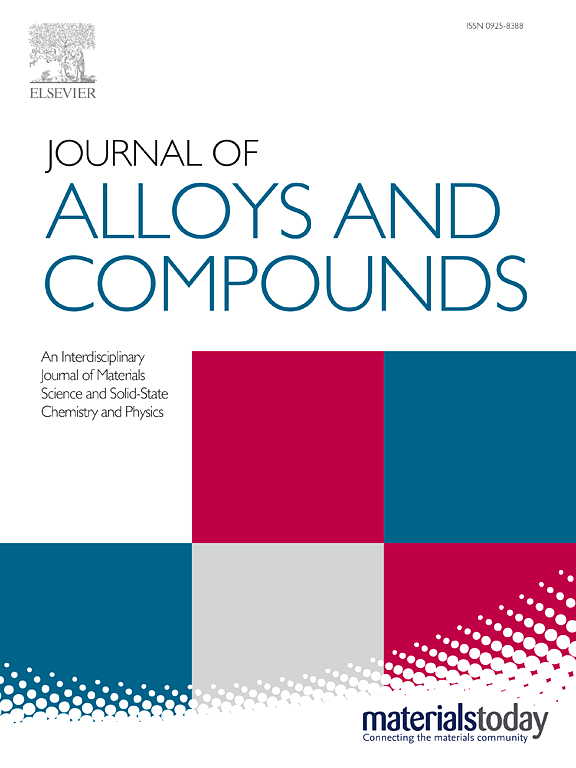TiB2粒度对Nd-Ce-Fe-B烧结磁体组织和磁性能的影响
IF 5.8
2区 材料科学
Q2 CHEMISTRY, PHYSICAL
引用次数: 0
摘要
在Nd-Ce-Fe-B烧结磁体中加入钛作为添加剂,通过晶粒细化,显著提高了磁体的矫顽力。然而,原位形成的TiB2次级相在烧结过程中消耗了基体中的硼原子,从而限制了磁体的剩磁增强。本文研究了不同粒径(50 nm、500 nm和5 μm)的TiB2对Nd-Ce-Fe-B烧结磁体微观结构和磁性能的影响。随着TiB2颗粒尺寸的减小,剩余物(Br)减小,矫顽力(Hcj)增大。TiB2粒子引起的界面应力促进了ZrB2相的偏析,降低了TiB2相附近区域的B原子浓度。这种还原抑制了Nd2Fe15Ga2(B)相分解为Nd2Fe14B相,导致Nd2Fe14B相的比例降低。此外,针状ZrB2相的不规则生长方向不利于2:14:1相的取向,导致Br劣化。随着TiB2粒径的减小,接触面积和压应力增大,Nd2Fe15Ga2(B)相和ZrB2相含量增加。针状ZrB2相对磁体的晶界产生钉钉作用,阻碍了磁畴壁的运动,从而提高了磁体的Hcj和热稳定性。控制TiB2的粒径是平衡Hcj和Br的关键。然而,颗粒尺寸的减小不可避免地会导致团聚,这对未来通过减轻TiB2团聚来提高磁性能和改善微观结构的努力提出了重大挑战。本文章由计算机程序翻译,如有差异,请以英文原文为准。
Impact of TiB2 particle size on microstructure and magnetic properties of Nd-Ce-Fe-B sintered magnets
The incorporation of titanium as an additive in Nd-Ce-Fe-B sintered magnets significantly enhances the coercivity through grain refinement. However, the in-situ formed TiB2 secondary phase consumes boron atoms from the matrix during the sintering process, thereby limiting the remanence enhancement of the magnets. Here, we investigate the impact of TiB2 addition with various particle sizes (50 nm, 500 nm, and 5 μm) on the microstructure and magnetic properties of Nd-Ce-Fe-B sintered magnets. As the size of TiB2 particles declines, the remanence (Br) decreases while the coercivity (Hcj) increases. The interfacial stress induced by TiB2 particles promotes the segregation of the ZrB2 phase, reducing the concentration of B atoms in regions adjacent to the TiB2 phase. This reduction inhibits the decomposition of the Nd2Fe15Ga2(B) phase into the Nd2Fe14B phase, leading to a decrease in the proportion of Nd2Fe14B phase. Additionally, the irregular growth direction of the acicular ZrB2 phase is detrimental to the orientation of the 2:14:1 phase, causing the deterioration of the Br. As the TiB2 particle size decreases, the contact area and compressive stress increase, along with a rise in the content of Nd2Fe15Ga2(B) phase, and ZrB2 phase. The acicular ZrB2 phase exerts a pinning effect on the grain boundaries (GBs), hindering the motion of magnetic domain walls, and thereby enhancing the Hcj and thermal stability of the magnet. Controlling the TiB2 particle size is crucial for balancing the Hcj and Br. However, the reduction of particle size inevitably leads to agglomeration, posing significant challenges for future efforts to enhance magnetic properties and refine the microstructure through mitigating TiB2 agglomeration.
求助全文
通过发布文献求助,成功后即可免费获取论文全文。
去求助
来源期刊

Journal of Alloys and Compounds
工程技术-材料科学:综合
CiteScore
11.10
自引率
14.50%
发文量
5146
审稿时长
67 days
期刊介绍:
The Journal of Alloys and Compounds is intended to serve as an international medium for the publication of work on solid materials comprising compounds as well as alloys. Its great strength lies in the diversity of discipline which it encompasses, drawing together results from materials science, solid-state chemistry and physics.
 求助内容:
求助内容: 应助结果提醒方式:
应助结果提醒方式:


